Zucchini is a favorite of home gardeners for good reason: it’s prolific, easy to grow, and the fruits taste so darn good.
But these plant may be attacked by a whole range of diseases, from bacteria that can kill off your plants in a matter of days, to fungi that can make the fruits rot right on the vine.
Luckily, many of these diseases are treatable, and you can head off a range of issues with some preparation and good gardening practices, all of which we’ll discuss here.
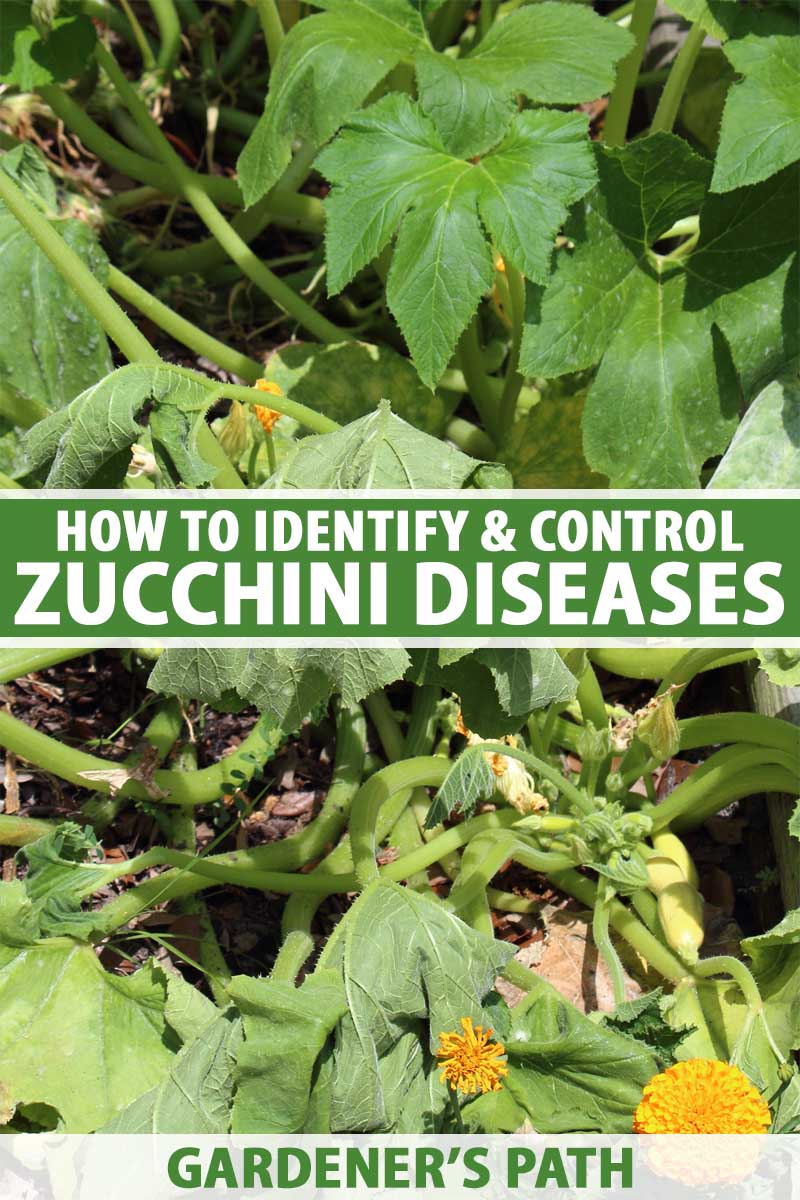
We link to vendors to help you find relevant products. If you buy from one of our links, we may earn a commission.
You can learn more about how to plant and care for zucchini in our growing guide.
Here’s the lineup:
The Top 11 Zucchini Diseases
Keep in mind that different pathogens can have more of an impact in different climates and growing areas. What may ravage your garden in the West may not bother plants at all on the East Coast. On top of that, the time of year that a disease is active varies from region to region.
Since so many diseases have similar symptoms, it can help to check with your local extension office to find out what typically plagues plants in your neighborhood. You can also chat with neighbors to see what problems they’ve dealt with.
Keep an eye on your garden from year to year and make a note of planting dates, time to harvest, and any infections or signs of disease on your plants in your gardening journal. This will also help you to develop a crop rotation plan, and serves as a helpful reminder of any problems you encountered in previous years.
Then, use the following guide to get a handle on your gardening foes.
1. Alternaria Leaf Blight
Alternaria leaf blight is caused by a fungus, Alternaria cucumerina, that shows up as yellowish-brown spots with a yellow or green halo that form on leaves. It attacks the older parts of plants first, before spreading to younger leaves.

Left unchecked, these spots will expand and eventually merge. They become necrotic and cause leaves to curl up and die. The fungus can also cause lesions to form on the fruits.
This disease prefers hot, humid areas with lots of rainfall, and usually pops up in midsummer.
How to Deal with Alternaria Leaf Blight
The first step to ward off an infection is to avoid watering plants from overhead. Instead, avoid the foliage altogether and only water at the base of plants. This disease may spread via water, and the spores need moisture to germinate, so keeping it off your leaves as much as possible helps.
To be extra safe, always keep your garden beds weeded, as these can also play host to the fungus. Crowded beds limit airflow and can cause a build up of humidity – prime conditions for spore germination.
If your plants show signs of this disease, you have a few options.
First, trim away infected leaves and ensure you’re watering at ground level, at the crown of your plants.
If the disease continues to spread, with leaves developing large areas of necrotic tissue, copper-based fungicide sprays are a good choice. Apply every 7-10 days.
You can also use copper-based fungicides preventatively, if you’ve had problems with Alternaria in the past.
Biofungicides containing Bacillus subtilis can also be effective.
Check out our guide to learn more about using Bacillus subtilis in your garden.
Be sure to clean up your garden beds in the fall. This disease can overwinter in the soil or on plant debris.
Always follow good gardening practices and rotate your crops every 2-3 years. These steps should be sufficient for keeping this fungus in check.
2. Bacterial Leaf Spot
Bacterial leaf spot is caused by Xanthomonas campestris bacteria. It starts as small spots on leaves that form a small yellow margin. These spots grow and merge, eventually becoming necrotic.
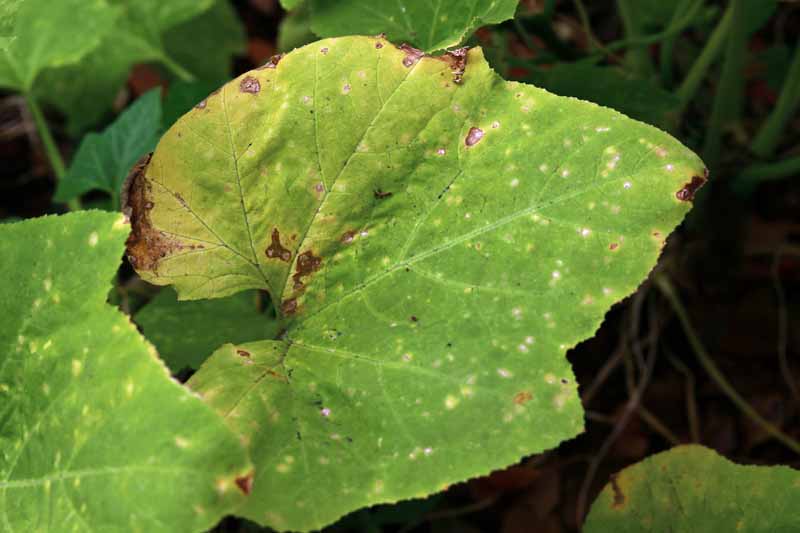
It also causes small, beige, indented spots on zucchini fruit.
It thrives in hot, moist weather and attacks plants through wounds or openings in the plant. It usually hits during the summer when temperatures are high.
How to Deal with Bacterial Leaf Spot
The most important step for preventing this disease is to buy certified disease-free seed, since leaf spot is a seed-borne pathogen. The second most effective preventative measure is to rotate your crops every two years.
If you catch this disease early enough, you can apply a copper-based fungicide to control it.
Once it catches hold, there isn’t anything you can do. Pull your plants and destroy them to avoid further spread of the disease.
Bacterial leaf spot can also be a problem in turnips.
3. Bacterial Wilt
Bacterial wilt in zucchini is caused by the bacterium Erwinia tracheiphila. It causes the entire plant to wilt, and leaves may turn dark green and dull, with discoloration on the stems.
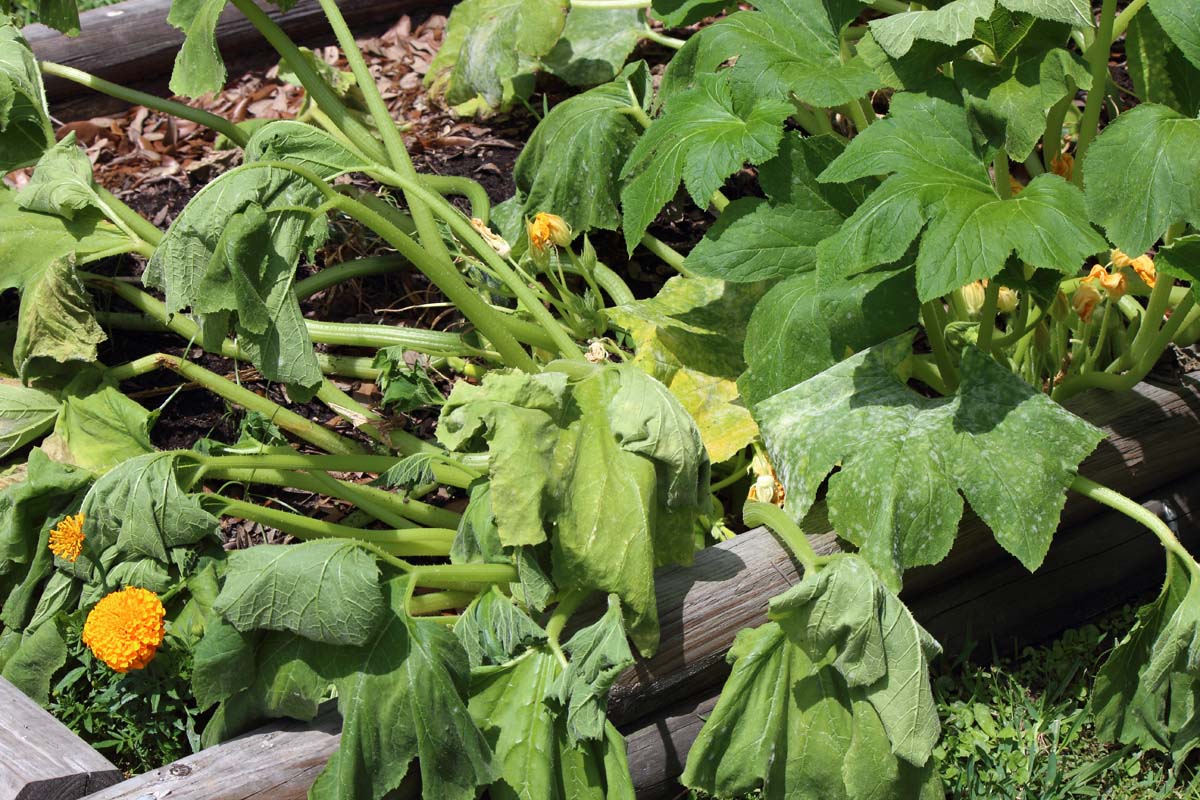
It sometimes starts with a few wilting leaves or runners here and there, but it can rapidly expand to take over entire plants. I’ve seen it kill a whole vine quickly, before I even realized anything was wrong.
Typically, plants are infected in June through August, when the bugs that spread the disease are active.
How to Deal with Bacterial Wilt
Bacterial wilt is spread by spotted and striped cucumber beetles, so keeping them away is your first line of attack. You can check out our guide to controlling zucchini pests for details on handling cucumber beetles.
Once the plant is infected, there isn’t anything you can do. Pull it out of the garden to prevent the disease from spreading to other squash plants. Don’t put the plant in your compost or you risk further spread.
4. Blossom End Rot
You’ll first notice this disease as light brown spots that develop at the blossom end of young fruit. As the zucchini grows, the spots turn dark and leathery, and expand.
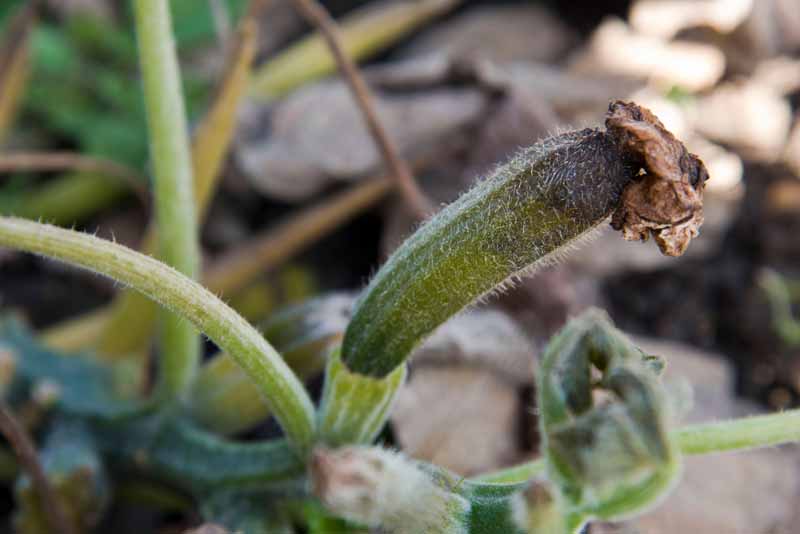
Blossom end rot isn’t caused by a fungus or bacterium. In fact, it isn’t really a “disease” at all, but rather, a physiological disorder caused by a lack of calcium in your plants. You won’t know they have it until the fruits begin to form.
This condition is commonly found in tomatoes, particularly during a drought, or in very dry conditions.
How to Deal with Blossom End Rot
Since the problem stems from a lack of calcium, you’d think adding calcium to the soil after the symptoms have developed would help. But it won’t.
Instead, you should test your soil before planting to see if it may have a calcium deficiency.
If so, add calcium to the soil before planting. Gypsum (calcium sulphate) or calcium chloride can both be used to add calcium without altering the soil’s pH.
If your soil has enough calcium and the developing fruits show signs of blossom end rot, the problem is that your plant isn’t getting enough water to transfer the calcium to the plant tissues.
Make sure your plant is getting plenty of water at regular intervals. If you can stick your finger an inch deep into the soil and it’s dry, your plant isn’t getting enough water.
You should also avoid applying too much nitrogen fertilizer to your plants because this can cause vigorous leaf growth, which takes up a lot of calcium from the soil as well.
Learn more about blossom end rot of zucchini in our full guide.
5. Cucumber Mosaic Virus
Cucumber mosaic virus causes plants to be seriously stunted. The leaves will have a mosaic-like pattern and may curl downwards. It can also cause fruits to be small, distorted, and discolored, with rough skins.
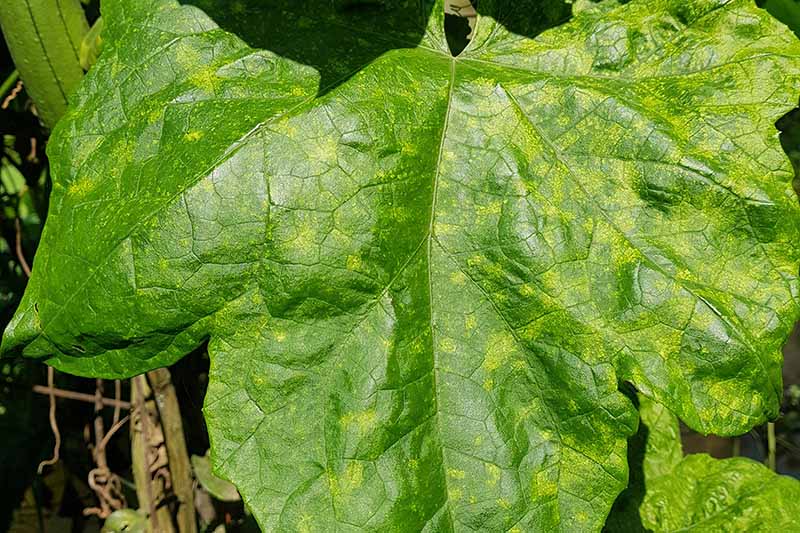
It’s spread by aphids and cucumber beetles, or contaminated garden tools.
Your plants can become infected anytime aphids are active, which usually spans the entire growing season. Weeds and plants like burdock, milkweed, horsenettle, jimsonweed, pokeweed, and alfalfa can act as hosts.
How to Deal With Cucumber Mosaic Virus
Once it has the disease, sadly, your plant is toast.
Next year, look for resistant varieties when you choose your cultivars. Keeping aphids and cucumber beetles away from your crops is your best defense.
Reflective mulches and row covers can help with this, but keep in mind that you’ll need to remove the row covers once plants start blooming, so they can be pollinated. Alternately, you can hand-pollinate your plants and keep them covered.
Insecticides won’t work in this case. By the time the aphid, for example, has been killed by the poison, it will likely already have spread the disease.
Planting a trap crop can help, as well. About two weeks before you plan to plant your zucchini, plant a row of sunflowers about 10 feet away from your intended planting location to attract the aphids.
This is where insecticides can help. Once you spot aphids on the sunflowers, you can then spray the plants with neem oil or insecticidal soap to kill the pests before they can move on to your zucchini plants.
You can also plant summer savory, basil, rosemary, lavender, garlic, or chives close to your zucchini plants. These act as repellants for many types of aphids. They should be planted at the outer edge of the garden where your zucchini plants will eventually grow.
Also, remember to clean your tools while you’re gardening. Each time you move from one plant to the next, wipe your tool down with a 10 percent bleach solution.
And be sure to maintain a perimeter where you keep weeds out at least 10 feet away from your zucchini plants.
6. Downy Mildew
Pseudoperonospora cubensis is a fungus-like pathogen known as an oomycete – or water mold – that attacks squash plants, causing downy mildew. It turns up as pale green or yellow angular spots on the leaves of plants. You may see a gray fuzz on the undersides of leaves as well.

Eventually, the leaves will turn brown and they may curl.
The pathogen thrives in wet, humid conditions. This disease usually takes hold towards the end of the growing season.
How to Deal with Downy Mildew
As with other many other diseases, prevention is key. Water at the base of plants, and don’t overcrowd them. Providing adequate spacing and ground-level irrigation allows for good air circulation, and prevents water from sitting on the leaves of your pants.
Keep an eye out for the telltale spots and apply a fungicide containing cyazofamid, fenamidone, or phosphorous acid at the first sign.
If the disease has already taken hold of your plant, pull and destroy it to avoid further spread of disease throughout your garden. Downy mildew attacks a wide range of plants. Don’t compost the zucchini.
Be sure to clean up the area where the plant was growing so that the pathogen doesn’t overwinter in debris in the soil.
7. Fusarium Crown and Foot Rot
If your plant has Fusarium crown and foot rot, you’ll notice wilting leaves followed by the entire plant wilting. Within a few days, the plant may die. This disease is caused by the fungus Fusarium solani.
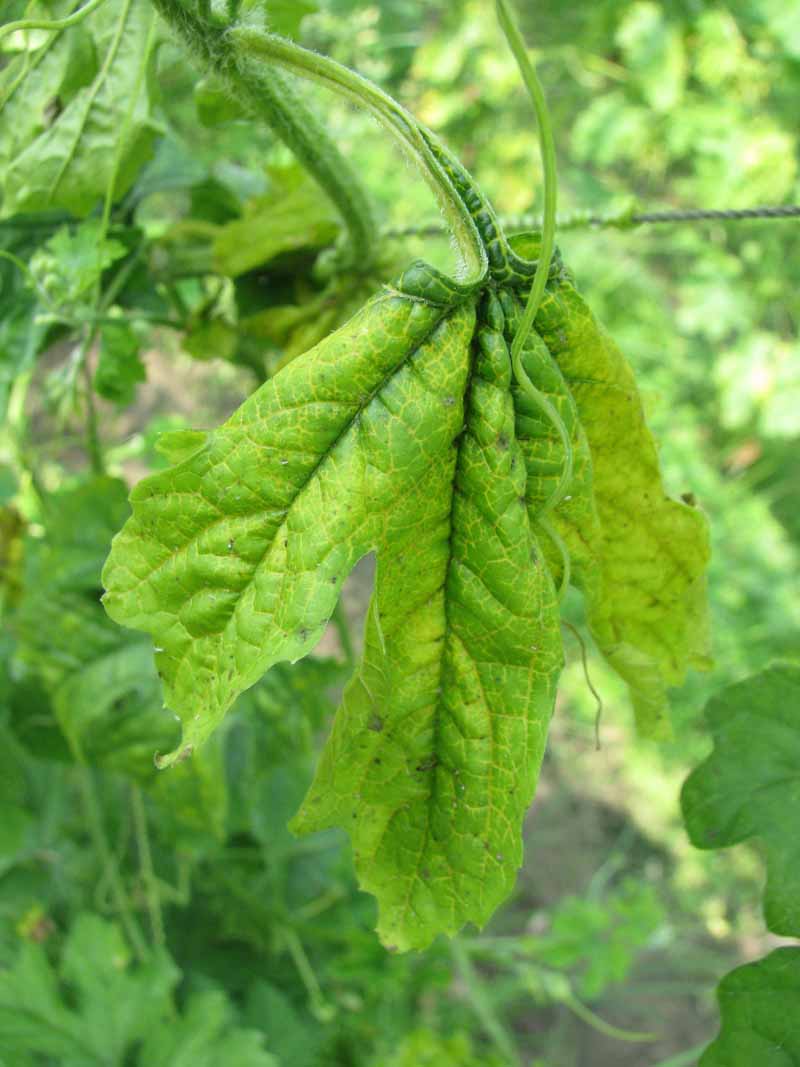
The symptoms are similar to those seen in with Fusarium wilt, which causes stunted growth, wilting foliage, and death of the plant.
In the case of Fusarium crown and foot rot, if you examine the crown of the plant, you’ll notice necrotic tissue, or a white or pink fuzzy growth right at or just below the surface of the soil.
The disease is both soil-borne and seed-borne. It pops up during the warm summer months.
How to Deal with Fusarium Crown and Foot Rot
The best way to deal with this disease is to avoid it in the first place. Fungicides generally aren’t effective in treating it.
Be sure to rotate your crops at least every two years and buy certified disease-free seed. If your plants are infected, pull them and don’t plant anything in the squash family there for three years.
In the future, be sure not to over or under water your plants, and maintain good air circulation by planting with appropriate spacing.
Read more about Fusarium crown rot.
8. Powdery Mildew
The dreaded powdery mildew is caused by a variety of fungi. Erysiphe cichoracearum, Sphaerotheca fuliginea, and Podosphaera xanthii are the types that most commonly impact zucchini. It thrives in warm, humid conditions. Symptoms usually appear in mid- to late summer.
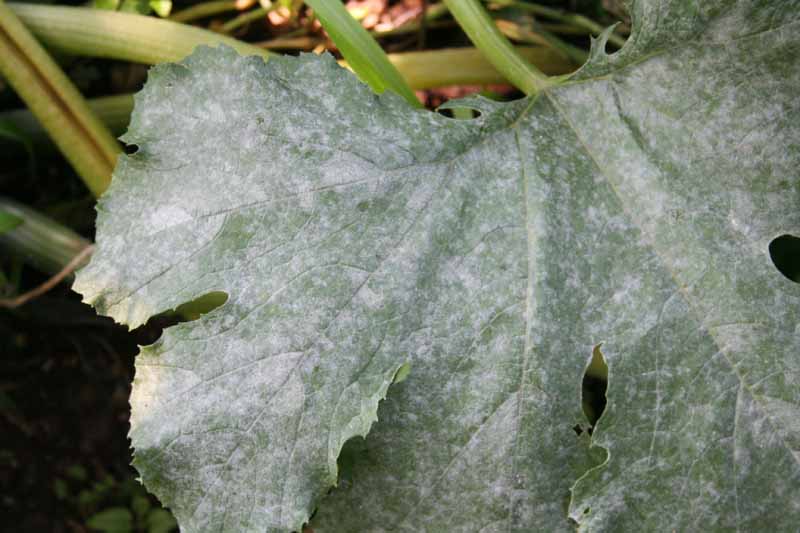
You’ll first notice pale yellow spots on the leaves, followed by a powdery coating that looks like someone dusted your plants with flour. It can make your plants weak, and can cause fruit to ripen early and be of poorer quality. It can also cause leaves to die off.
How to Deal with Powdery Mildew
Good air circulation is key in preventing powdery mildew. Make sure your zucchini has plenty of room to spread, and don’t let weeds creep in around your plants.
Examine your plants once a week for signs of this disease, since early action is important for putting a stop to it.
Some gardeners, like yours truly, struggle with this disease nearly every year. If that’s the case, you can use a sulfur-based fungicide or neem oil early in the growing season as a preventative measure. If you find your plant has it, neem oil can help slow its spread.
Keep an eye out for resistant zucchini varieties if this is something you’ve struggled with in the past.
9. Septoria Leaf Spot
Septoria cucurbitacearum is another fungus that attacks zucchini plants. It’s mostly found in the Northeast and Midwest. You can identify it by the small circular beige or white spots surrounded by a brown border that appear on the leaves.
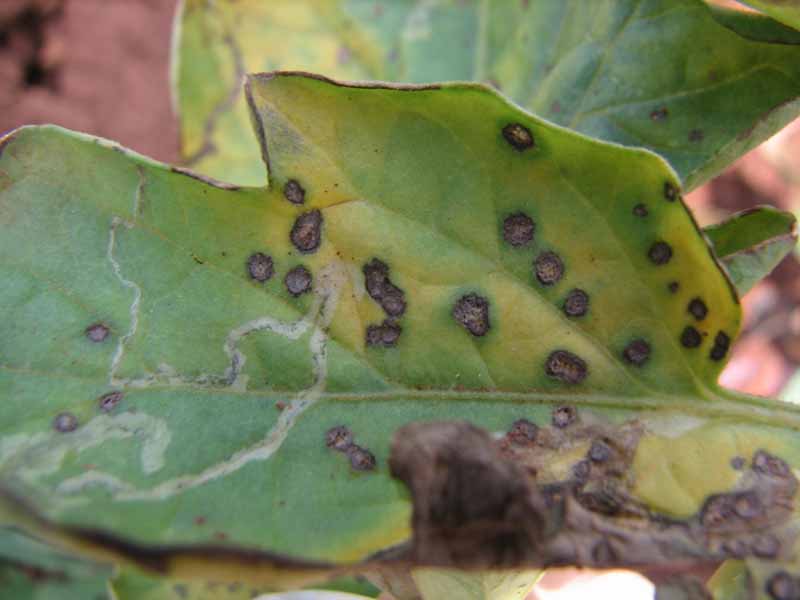
It can be carried through water and thrives in moist, humid conditions when temps are in the low to mid-60s. It may go dormant when temperatures heat up in the summer, but it will likely return in the fall.
How to Deal with Septoria Leaf Spot
Because it can overwinter on plant debris, it’s important to clean up your garden beds in the fall.
If you spot this disease, trim away infected leaves and treat plants with an organic copper or potassium bicarbonate-based fungicide.
You can also use a chemical-based fungicide containing chlorothalonil.
10. Verticillium Wilt
Verticillium dahliae, the fungus that causes verticillium wilt, attacks hundreds of different plants, including zucchini. It prefers cooler weather but it usually isn’t evident until midsummer.
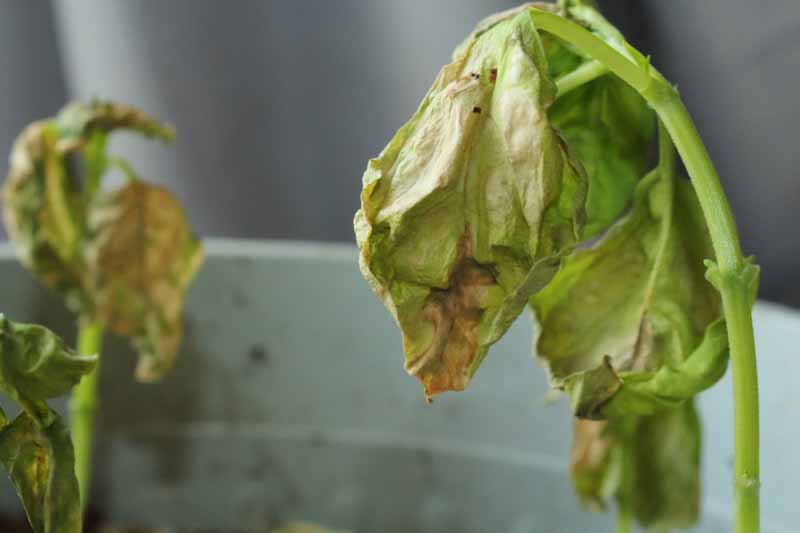
Usually you’ll notice the leaves turn yellow before they wilt and die.
You may first notice the plant wilting in the daytime and perking back up at night. Sometimes only half of the plant will wilt, while the other half looks fine.
How to Deal with Verticillium Wilt
Once a plant has Verticillium wilt, there’s nothing you can do to get rid of it. Pull up the plant and dispose of it.
In the future, rotate your crops. Look for varieties that are resistant. They’ll usually be marked with a “v” after the variety name. You should also clean your tools with a 10 percent bleach solution in between plants.
Also, keep weeds that may act as hosts away from your garden.
11. Zucchini Yellow Mosaic
Zucchini yellow mosaic virus shows up in a variety of ways. It can cause plants to be stunted and fruits can be deformed.
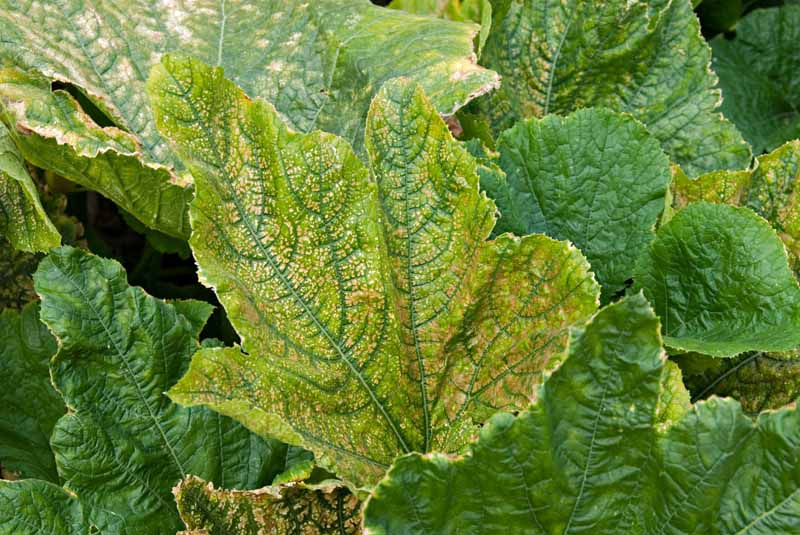
The leaves may have a yellow mosaic pattern and they may be small or deformed. The leaves or fruit may become necrotic.
It is sometimes mistaken for cucumber mosaic virus, which exhibits similar symptoms.
How to Deal with Zucchini Yellow Mosaic
Once a plant has this disease, you can’t cure it. The plant will die eventually die and you could lose your entire harvest. Remove diseased plants to prevent it from spreading.
It can’t survive without a live host, but it can live on any plant in the cucurbit family. Make sure to clean up your garden in the fall and rotate your crops.
The virus is spread by aphids, so keep them away from your plants. It can also be spread on footwear or tools, so be sure to clean your tools and gardening shoes with a 10 percent bleach solution when moving between garden areas.
No Matter the Problem, Use Good Practices
If you decide to grow zucchini, there are a few things you can do to ward off most diseases. These good practices can help to prevent all kinds of problems down the road.
In general, no matter what disease you’re targeting, it’s a good idea to practice crop rotation. Don’t plant something in the squash family in the same place for more than two years in a row.
You should also clean up your beds in the fall to avoid giving pathogens a place to overwinter.
Try to water at the base of plants, not on the leaves. This goes a long way toward preventing fungi and mold from getting a foothold on your plants.
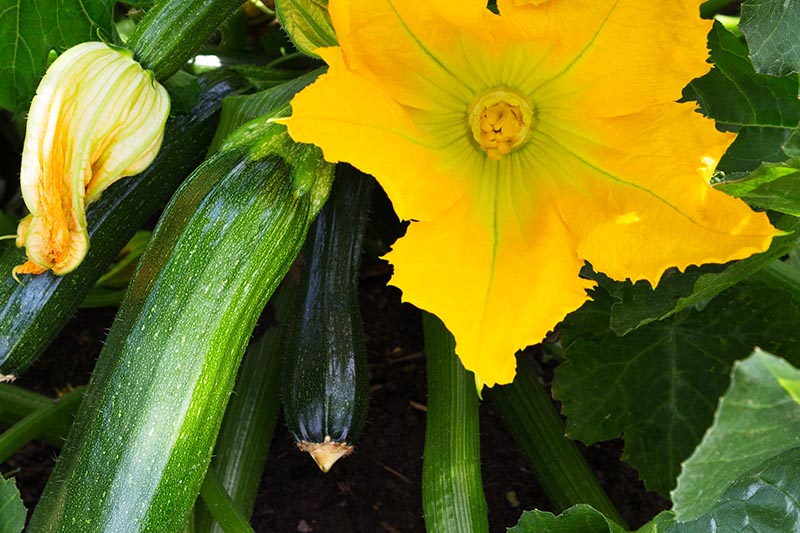
Finally, keep weeds out of your garden. They may seem harmless, but they compete with your plants for nutrients, which can make them more susceptible to disease. They also act as hosts to some diseases.
Hopefully you feel armed and ready to deal with anything that tries to take down your zucchini crop this year. I’d love to hear from you if you do encounter a disease – though my fingers are crossed that you won’t. Let me know what you encounter and how you tackle it in the comments below.
For more help with growing zucchini, check out these guides next:

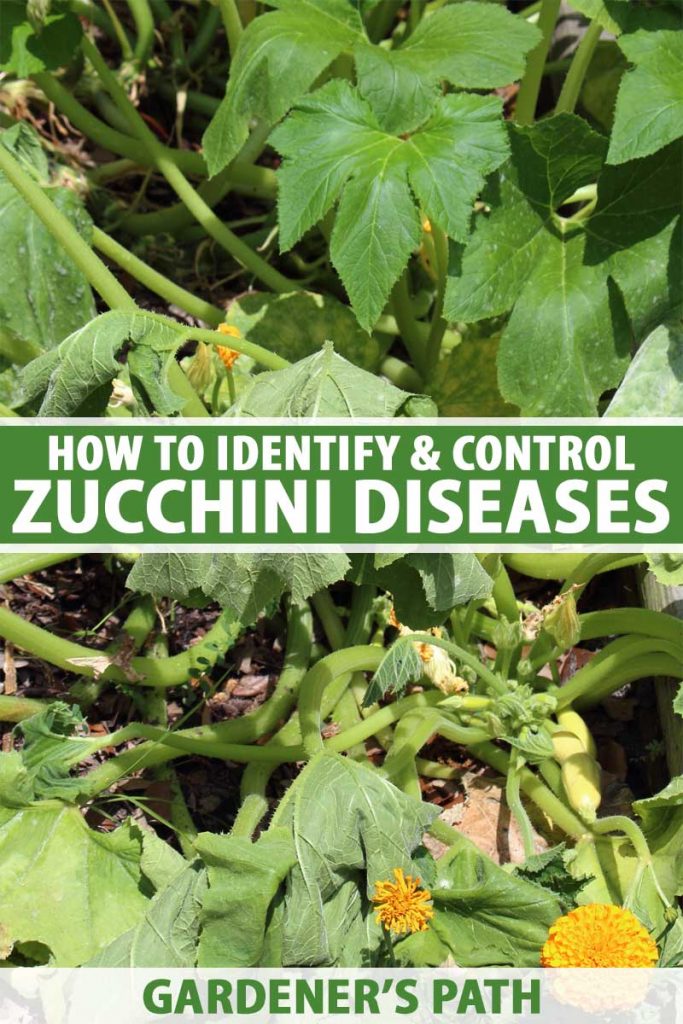

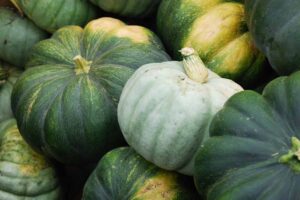

planting zucchini for the first time
Wonderful, good luck Loraine! Please let us know if you have any questions along the way.
I came home tonight to see one of my zucchini plants leaves are curling at the edges and turning brown. I looked for an answer and basically have come up with nothing that possibley could be the problem. I did remove the infected leaves.Should I remove the plant ? ????
Hi Michael, don’t remove the plant, yet. There are a lot of reasons that the leaves may start curling and/or turning brown. Have the leaves turned yellow or lighter at all? Do you see any spots or discoloration? Sometimes a secondary symptom can help us narrow things down. Also, check for the most common issues before you give up on this plant. First, is the soil overly wet or dry? It should feel like a well-wrung out sponge. Have you been feeding your plant? It could be a nutrient deficiency. If it’s none of those, do you see any bugs… Read more »
my baby zucchini are turning yellow and dying. is this blossom end rot? they aren’t getting dark.
Need to know what is causing this on my zucchini
Hi Linda, this actually looks like slug/snail damage to me. Often, snails nibble on the young fruits. When the fruit matures, the damage grows along with it and can take on an appearance that looks like that in the image you provided.
Do you know what type of disease this is Kristine?
Rather than a disease, this looks similar to damage from squash vine borers. Did you notice any small cream-colored larvae in the soil or in the vine when you pulled it? Was there any wilting? Take a look at our guide to zucchini growing problems for more info: https://gardenerspath.com/plants/vegetables/zucchini-growing-problems/
My zucchini plant ???? leaves had tiny white spots . Treated it with need oil spray and baking soda+soap spray for the last 4 days. Slightly better but problem is persisting. Any suggestions? Pic attached
Pl advise if I should pull it out as I have squash planted next o it . Thank you
That’s frustrating. I actually notice some other signs that there might be something else going on rather than powdery mildew. First, try rubbing off the spots with your fingers. Do they come off? If not, it’s not powdery mildew. It could be downy mildew, which requires a fungicide to treat. Something like Bonide Infuse will work. It could also be squash bugs, which cause white stippling and the ragged holes that some of your leaves have. Check the underside of your leaves for eggs and beetles. Look at the section for squash bugs in our zucchini pest guide for more… Read more »
Any idea what is wrong with my zucchinis? They are very small (less than my pinky finger) and are not growing. They are spiny looking. A lot of roly poly bugs are hanging around them as well. Tried to attach an image, not sure if it went through. Thanks
Hello. I have a few zucchini plants that are growing very nicely. I started to get these yellow leaves. The fruits are growing well . Any ideas as to the problem. I am attaching pictures. Thank you for any information.
Hi Joe, can you try attaching the images again? I can’t see them here.
Any suggestions?
My zucchini exhibited yellow mosaic so I dug them all up as they all had it. I then proceeded to wash down all gardening tools and my boots with 10% bleach. My cucumbers at the other end of garden are not large enough in determining if it has transferred to them. Keeping fingers crossed.
Good luck! Mosaic can be so frustrating, but you never can tell if it will leave your plants alone or not each year. Hopefully, this is a good year!